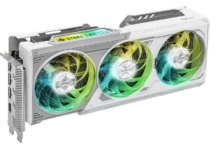Today, it’s time for Arctic Cooling to make a display with its VGA Silencer. Admittedly, I had fairly high expectations of this product. Partly because I’ve used Arctic Cooling’s CPU cooler before and been tremendously happy with these (great performance and almost solely quiet), but not the least because those that already have examined this cooler have been very positive.
Two things that have progressively walked hand in hand for
the past few months are silent computers and overclocking. Watercooling, for
instance, lowers the noise level of the computer remarkably and for a few
months ago, we tested the passive cooling solution from Zalman – of which
successor was inspected just recently.
Today, it’s time for Arctic Cooling to make a display with
its VGA Silencer. Admittedly, I had fairly high expectations of this product.
Partly because I’ve used Arctic Cooling’s CPU cooler before and been tremendously
happy with these (great performance and almost solely quiet), but not the
least because those that already have examined this cooler have been very
positive.
To cool a modern graphics card is obviously no simple task.
nVidia is a telling argument for this with its 5800/5900 cards. In fact, VGA
Silencer borrows the blower from FlowFX or ABIT’s OTES. That, however, is
also roughly the only resemblance. Let’s have a look at this package.
Arctic Cooling
is a well established manufacturer as of today, hence it doesn’t require an
extensive presentation. However, VGA Silencer is something completely new
for Arctic Cooling since it is its first graphics card cooler. The cooler
was first sighted together with the HIS Radeon 9800 Pro IceQ, which is being
sold with this cooling pre-connected.
| Dimensions: | 185 x 84 x 34 mm |
| Weight: | 278 grams |
| Material: | Aluminum |
| Fan speeds: | 1200 and 2400 rpm |
| Suitable for: | Radeon 9500 – 9800 Pro and GeForce 3 Ti200-Ti500
|
| Estimated price: | €16 (exchange rates) |
A fast look at
the specifications directly exposes some important things. The product is
made of aluminum and it weights a whole lot (which means that it has much
heat-spreading material). The fan operates in two different levels where both
levels are low, so the faster level is not deafening at all. If you have a
Radeon 9500-9800Pro or a GeForce 3, it’s just to go straight ahead, but if
you have another graphics card you should contact Arctic Cooling and ask how
it will work with your graphics card. The fact is that Arctic Cooling has
written on the box that its homepage is being updated with information about
compatibility. However, no update has been done yet even though the product
has been available for over a month.
Finally, we see something really pleasant: the price – only €16.
|
|
|
To the left,
you have the package’s entire contents. The cooling block and the belonging
back plate is present. Furthermore, we see the clip (the blue little thing)
which you mount on the card’s underside and fasten the device with. The package
also includes a small tube of thermal compound. To the right, we have the
cooling’s underside, e.g. the side that has contact with the GPU. It’s really
not a well-polished surface, but on the other hand, the core of the Radeon
9×00 cards are surrounded with a shim which prevents direct contact with the
cooler. Briefly, this means that you will have to add a whole lot of thermal
compound.
|
|
On the left side,
we have the product mounted completely. Installation is very easy and as long
as you’ve passed the junior level of compulsory school, there shouldn’t be
a problem even without manual. The mounting for me took about 5-10 minutes
– that includs washin my hands since I got thermal compound all over me when
I assembled it all together.
Off to the right,
there’s a little problem which comes up with certain cards; we have a margin
of about 7 millimetres (which is stated as normal in the manual) between the
bracket and the cooling. Shortly, we will have a bit of heat air waste in
the case. The cards that won’t get this problem isn’t listed anywhere. The
most essential is however how the product performs, so it’s time for you to
browse to the next page.
As Radeon 9800
Pro does not have a built-in temperature sensor and we did not have any reliable
external one at hand, we have to be content with looking on how the cooling
affected the overclocking potential. We simply compared how high memory and
GPU could be clocked with standard cooling and VGA Silencer in both high and
low settings, respectively
| ||||||||||||||||||||||||||||||||||||||||||||||||||||||||||||||||||
3.4 % increase
on core and 1.3 % increase on the memory banks are hardly bad, especially
not when the cooling generates less noise than the original. The cooling has
an exhaust, and despite the fact it is not entirely fit, it should help lowering
the case temperature.
| |||||||||||||||||||||||||||||||||
Just looking
at the figures, this does not impress, but 4.8 % is not that bad considering
that the primary task of this cooling is to cool the graphics card. Keep in
mind that these results come from a moment of maximum overclocking(!). Probably,
you could have slightly better results on graphics cards where this loose,
mentioned on previous page, is absent.
Overall, we have increased overclocking and lowered the temperatures at the
same time.
This is a very silent cooling device. The differences between high and low
are almost non-existent concerning noise levels, and still, high is less noisy
than the standard cooling that was mounted on our Radeon 9800 Pro. What more
to ask?
By now, you’ve
probably understood that we like this product.
|
Let’s put it
like this: If you have €15 and a spare PCI slot, the VGA Silencer is
a given choice.
Along with the reference-cooling for the GeForce FX 5950 Ultra, we have seen
discussions on which is the wiser choice: the intake of air or the outtake
of air. Personally, I like the idea to exhaust air from the system. Decreasing
the ambient temperature is never wrong.
It’s not much
more to say, I’m afraid. We’ll let the VGA Silencer bask in the glory of our
editor’s choice award. Cheap, silent and efficient – what more do you need?

Arctic Cooling VGA Silencer
Thanks
to Rotakorn for providing
the VGA Silencer

























